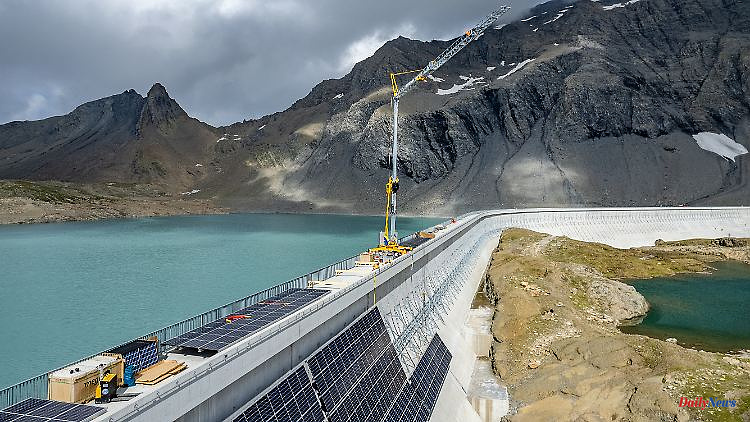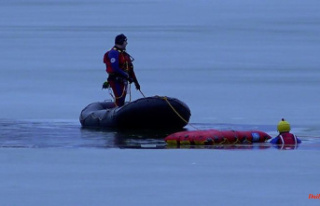In order to achieve the climate goals, Switzerland wants to invest heavily in the expansion of alpine solar systems. While there is a gold rush mood among energy companies, landscape conservationists fear species extinction and other horror scenarios.
For astronaut Buzz Aldrin, it's the most amazing scenery he's ever seen, and he's been to the moon, after all. At least that's how he described the Saflischtal in the Swiss canton of Valais at an altitude of more than 2000 meters in a 2015 commercial. Now nature is in danger there, say landscape conservationists. A gigantic solar system is planned for the mountain village of Grengiols, the size of 700 soccer fields. And not only there: Dozens of projects have been launched since Parliament promised billions in subsidies. There is a gold rush atmosphere in Switzerland.
In Grengiols, around 600 members of the Saflischtal interest group are mobilizing against the plans, including 42-year-old Ulrike Steingräber-Heinen. She is from Magdeburg, worked for nine summers as a shepherd and cheese maker in the region and is now married to a local farmer. Solar power to reduce greenhouse gases is important, she tells the German Press Agency. "We have a photovoltaic system on the roof ourselves. But it can't be the goal to destroy nature in order to protect nature."
The new energy law facilitates approvals for alpine projects and promises money. But if you want to do it, you have to hurry: "Systems that feed at least some electricity into the power grid by December 31, 2025 will receive a one-time payment from the federal government of a maximum of 60 percent of the investment costs," according to the law. "Solar power bonanza in the mountains" wrote the "Neue Zürcher Zeitung".
Suddenly the Alps are no longer just a leisure paradise with pastures for the production of good mountain cheese. They could also help Switzerland out of the energy dilemma. "We have many areas that would be suitable in terms of solar radiation," says Jürg Rohrer from the Zurich University of Applied Sciences. The lecturer for renewable energies is a pioneer of alpine solar systems.
What makes them so attractive is that they deliver good electricity even in winter because they are usually located above the blanket of fog, are very efficient when it is cold and benefit from reflections from the snow. Rohrer has had a test facility with various solar modules near Davos since 2017. "In winter they produce three to four times as much electricity per area as plants in the Central Plateau," he says. So far, the potential has been practically unused: apart from a small solar system in Austria, according to him, there is nothing in the Alps in the open.
"We could produce 40 terawatt hours with alpine systems, two thirds of the current electricity requirement," says Rohrer of the dpa. "But you have to keep in mind that the areas have to be reasonably accessible." There are other renewable energy sources, such as hydropower, or solar capacity on roofs and on highways. He considers alpine solar systems with a potential of around five terawatt hours to be realistic in the next few years. This would require a total area of 30 square kilometers, as much as 4,200 soccer fields. That's little compared to 4,635 square kilometers of bare land, he says.
For many residents of Grengiols and the surrounding area, however, the project planned by the municipality and the local electricity company is a nightmare. They advertise resistance with a photo montage: they artificially placed thousands of solar panels on a photo of untouched nature for illustration purposes. Whether it would ever look like that is of course unclear. "Solar systems look like rock formations from a distance if you build them cleverly," says Rohrer.
"We graze our animals there in the summer," says Steingräber-Heinen. "The alpine pastures are poor anyway, but the construction with concrete supports, ground anchors and so on would damage the turf so much that grazing would no longer be possible." The area is in the Binntal Landscape Park, established in 2011 to preserve the beauty of the region. Sabrina Gurten, a biologist from Grengiols who is also opposed to the project, speaks of "faunistic and floristic treasures" in the area. Depending on the exact location of the plant, there is a risk that species will become extinct locally.
The Alpine protection organization Mountain Wilderness Switzerland is mobilizing against another project in Valais, in Gondo. Before the untouched and undeveloped nature is built over, one should first expand the potential with systems on buildings and infrastructure, it says there. Rohrer is also concerned that solar parks are now being planned quickly everywhere because of the deadlines for the subsidies. "They failed to include quality criteria," he says. "The crazy thing is that the subsidies don't care whether it's a good or bad location."
The Axpo electricity company has built the largest solar system in the Alps to date. Solar modules on the Muttsee dam in the canton of Glarus at an altitude of around 2500 meters have been producing electricity since August. The group has a lot of projects in the pipeline, such as Nalpsolar in Graubünden. In order to benefit from the subsidies, it should start supplying electricity from autumn 2025, as Axpo spokeswoman Jeanette Schranz says: "In our Nalpsolar project, around 30,000 solar modules are to be installed on pasture land, in an open area about the size of twelve soccer fields." Axpo has plans for solar systems with an output of more than 1.2 gigawatts in Switzerland, half of them in alpine regions. The energy group Alpiq also has three major projects in the pipeline.












